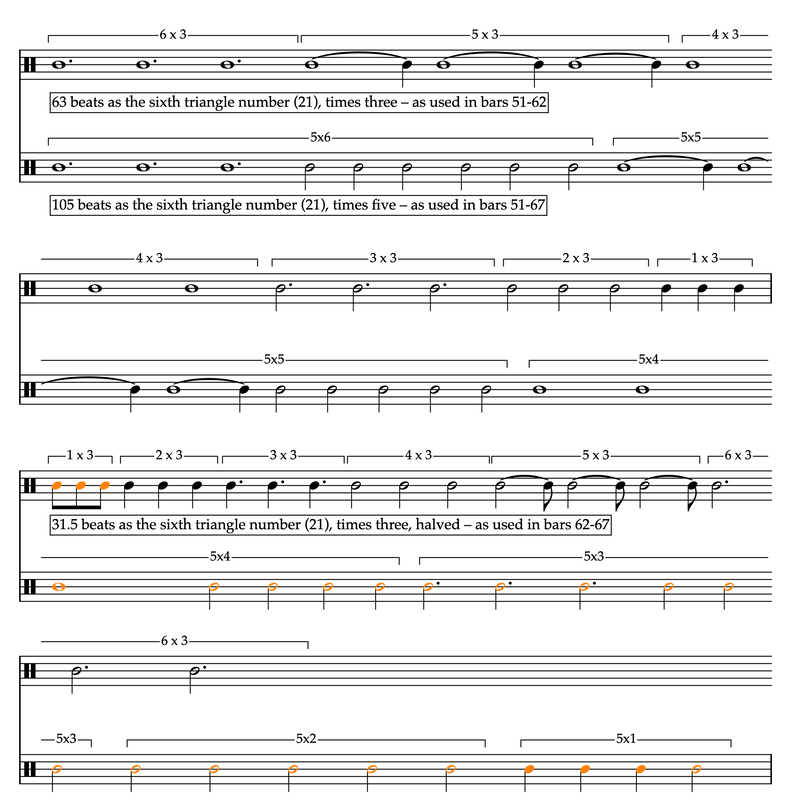|
It’s been quite something to see Psappha’s recording of my piece for accordion, Two Animals. Frankly, it brought me back around to a piece that I was anxious about. Miloš Milojević’s superb recording brings out everything I had hoped the piece might have, but that I was secretly afraid it lacked.
The piece had a troubled genesis. I had two different ideas: I wanted to have two separate rhythmic cycles, one seven minims long, one three minims long, which then create a 21-minim long superstructure. And I wanted the accordionist to sing.
These ideas were exciting but created traps.
The singing was beautiful but much quieter than the accordion. In the end, I couldn’t have it continue for the whole piece. It’s a hard thing to do while playing, and not worth it if it’s inaudible. My solution was to imagine the singing line being subsumed into the accordion part, which I rather like.
The idea of rhythmic cycles was, in part, drawn from the principles of Carnatic music. I noticed that 63 was a particularly fun number to play with. Firstly, it’s three times a triangle number, 21, which enabled me to create a rhythm of ever-increasing length. It is one away from a square number, 64. Square numbers allow you to put two triangular numbers back-to-back. (As 63 is one off, you’ll have to miss out the final 1-beat note, but that actually allows it rebegin very nicely.) Finally, it’s seven times a square number, nine. That allows for a rhythmic pattern of increasing and decreasing length in groups of seven.
My ambitious rhythmic idea was to find ways to use these overlaying patterns. I think you can hear this idea in the finished version, with its lengthening and shortening melodies. But I had initially attempted to stick to it rigidly, which quickly became an albatross around my neck. First, the level of change in the rhythmic line was extreme: from one crotchet at its quickest, to eight at its slowest. By the middle of the rhythm, it was too slow to be perceived as a rhythmic idea at all.
Second, the accordion is just one instrument, and balancing three simultaneous rhythmic cycles was going to result in fistfuls of notes. A purist approach, I suppose, would have been to go for strict three-part polyphony, but I couldn’t quite hack the rigour. I had two solutions to these problems. The first was to introduce some eccentricities into the processes. For example, in bars 39-49, the chordal line divides the 63-beat cycle using nine squared, times seven. But rather than just, say, repeating the patter 12321 seven times, or using the somewhat repetitive pattern in the bottom stave of the above example, I split the pattern in two. It begins each time with a six-beat note, then adds one crotchet on to the end for each six-beat note used.
The other solution was to break my own rules. The passage in bars 51-67 sets up two patterns. The first is a triangular pattern of 63 beats that is then reversed and doubled in speed. The second is a triangular pattern of 105 beats. I think I had planned some clever way to bring them together, but it was all scotched in the end. I just couldn’t get the rhythmic framework to sound right, musically.
The big triangular pattern was edited only ever-so-slightly: the three orange notes were made into crotchets. The more complex triangle was changed at the same point but then jettisoned from the orange notes onwards.
These are just some examples: the piece is full of rhythmic patterns that are set up, but often tweaked and edited as I grew frustrated with their confines. I never made use of eight squared, minus one at all. One day, I’d love to write a patterned piece that actually sees all the rhythmic patterns through. Similarly, I’d love to do a singing-drone work. I think both ideas would benefit from larger forces: there’d be more musicians to sing, and the additional musical lines would offer flexibility to the rhythmic ideas, enabling me to see them through. (I’m actually very tempted to arrange this piece for string ensemble. Maybe when work next dries up.)
With all that said, I view this piece as a successful experiment. It taught me a lot about these new ideas, and, in the hands of as sensitive a player as Miloš, is a rather nice tune. I think it captures the meditative feeling I was after, even if it got there in a different way than I had planned.
0 Comments
Leave a Reply. |
NewsYou can find out about recent and upcoming projects here, and stay up-to-date with email or RSS below.
Archives
July 2024
|
|
All photographs by Ilme Vysniauskaite
|



 RSS Feed
RSS Feed